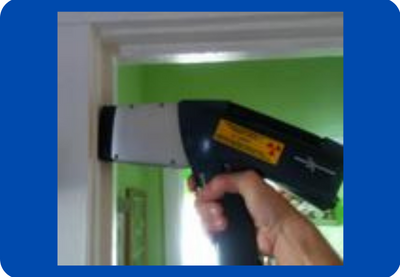Part III: Emerging Technologies And Supplemental Information
A Recap of the EPA-HUD Joint Workshop on Lead-Based Paint
On November 1 and 2, 2023, the U.S. Environmental Protection Agency (EPA) and U.S. Department of Housing and Urban Development (HUD) held a virtual technical workshop to hear from experts on specific topics such as the relationship between LBP and dust-lead and an update of existing and emerging technologies for detection, measurement, and characterization of low levels of lead in paint. This follows a Court order to EPA to reconsider the legal definition of Lead-Based Paint (1.0 mg/cm2 and 0.5%).
The following is an overview and my summary of the speakers and the information I thought was most helpful to the goal of the workshop (presentation titles were shortened for brevity). I have divided the presentations into three categories:
- Detection of Lead by Hand-held Fluorescence Instruments (XRF)
- Detection of Lead by Chemical Field Screening Tools (“Test Kits”)
- Emerging Technologies and Additional Supplemental Information
This article covers the presentations pertaining to chemical test kits used for lead detection. For a review of the XRF and test kit-related presentations (Parts I and II of this three part Article), refer to the links to those pages above.
The workshop presentations and subsequent public comments will be used to update the LBP standard definition. The public comment period is open and comments can be submitted via the EPA online docket until December 31, 2023.
This entire process is expected to take about three to four years.
An EPA summary of the presentations is expected to be published online in a few months.
Childhood Lead Exposure in the 21st Century, Dr. Mary Jean Brown, Department of Social and Behavioral Sciences, Harvard University
Dr. Brown provided a general overview and background on the history of lead exposure, including a recap of the substantial progress that has already been made. She observed how children of the 1960s and 1970s (which includes the author!) were expected to have been lead poisoned just by growing up around the use of leaded gasoline (typically a predicted blood level of 12-15 µg/dL).
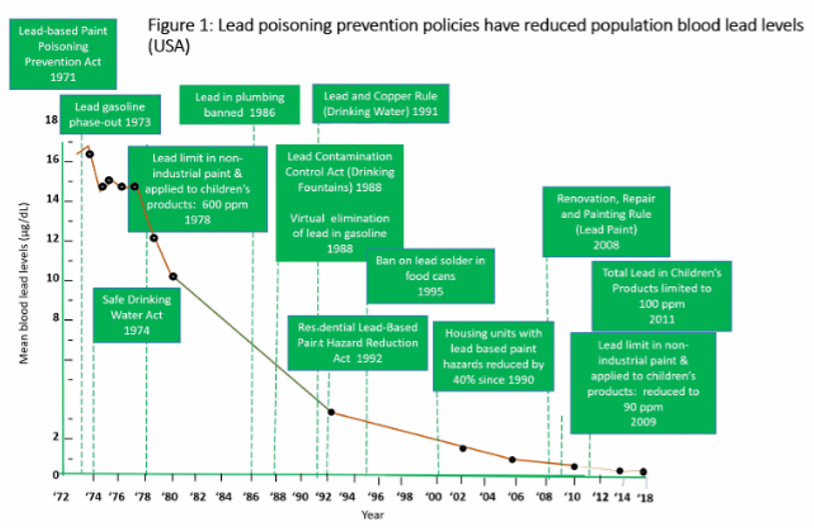
She observed that as we seek now to make relatively tiny additional gains it will take a much more complex approach, including a better understanding of background exposures to lead. She stated that the estimated worldwide background level of lead in soil is 17 ppm (Author note: which conveniently mirrors our default Michigan background level!).
Dr. Brown also made the case that reducing lead exposure will help reduce crime based on a number of studies showing a correlation.
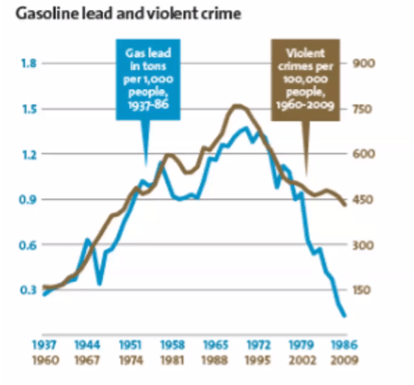
A question was posed to her noting that children growing up in deteriorated public housing that isn’t lead-safe, are often exposed in utero, to drugs and alcohol etc., have poor diets, and go to lower-performing school systems. Given that premise, to what extent can an association be established between lead and violent crime? She responded that some studies have been able to control for some of these factors such as a study performed by Dr. David Bellinger of affluent older homes in the Boston market.
On the other hand, she noted a study that stresses the importance of maintenance and housekeeping. A study of military housing with high levels of lead in paint showed extremely low lead exposures, apparently due to the culture of discipline with cleaning and related care associated with the military ethic. However, when cleaning and maintenance was left to private contractors on military bases, lead exposures increased.
She made some cautions that lead regulation of rental housing has to be thoughtful and market-specific to avoid unintended social justice consequences. In the instance of the Philadelphia PA housing market example, she noted that it has resulted in some de facto housing discrimination.
XRF Capabilities of Lead Testing of Water, Ms. Ornella Joseph (Doctoral Candidate), University of Notre Dame
There are no approved field screening procedures for testing lead in water. Home test kits sold do not detect particulate lead and therefore are of dubious value. With the development of the more sensitive SciAps XRF, they wanted to develop a corresponding water screening method to increase the rapidity of detection of lead in water compared to conventional laboratory analyses. They developed a method where a liter sample of water is filtered through a carbon felt filter. This filter is then dried and tested by XRF.
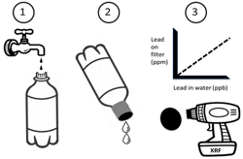
The test method involves the development of calibration curves based on the grade of carbon felt and the local water quality. Carbon absorption efficiency ranges from 10%-99+% and the specific water quality parameters such as chlorine, iron and hardness that can attenuate the XRF signal. Their initial 250 sample study yielded a 4% false positive rate and no false negatives! They were able to obtain a level of detection of 6 ppb.
The main limitation of this method is the difficulty of drying the filters in the sample homes. A validation of various proposed methods to accomplish this is pending.
Isotopic Analysis to Identify Sources of Lead, Jeffrey Raiche-Gill, Wisconsin Department of Health Services
Mr. Gill presented three case studies of child Elevated Blood Lead Level investigations (≥10 µg/dl). What was remarkable is that, in these three cases, a lead in paint hazard source was not evident. Consequently, they conducted isotopic fingerprinting analyses to try to match the lead isotopes in the child’s blood with the various possible sources in and around the home.
Lead isotope ratios from blood and environmental samples were analyzed using a high-precision multi-collector inductively coupled plasma mass spectrometer (MC-ICP-MS) to determine the exposure source. Sampled sources included paint, dust, imported spices, ceremonial objects, soil, pipe solder and water to attempt to identify the source(s). The isotopic ratios were then calculated and presented in summary table form to attempt to identify matches. The following table provides an example:
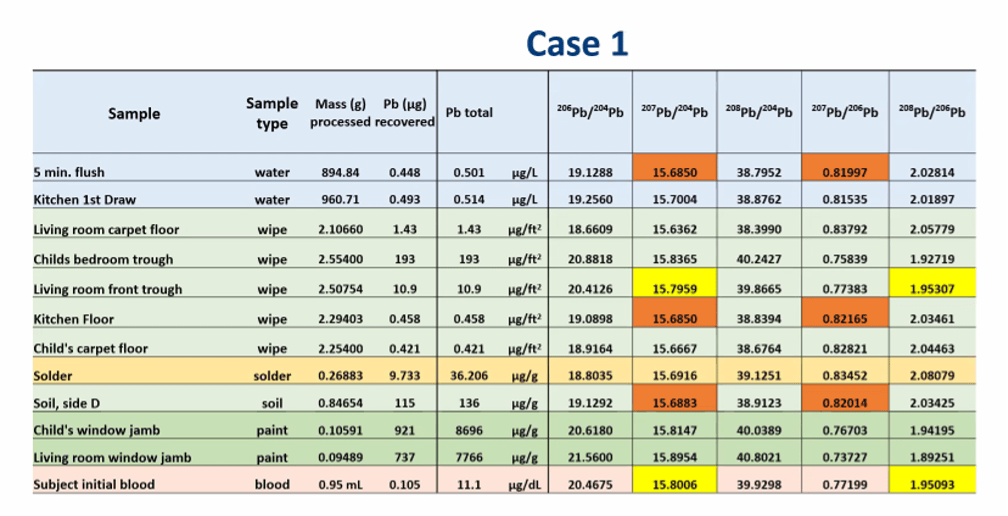
As indicated in Case Study 1 above in yellow, a close match was found with the dust in the Living Room window trough, which the parent confirmed was a favorite place for the child to watch outside with the window open. Also, of notable interest (but not matching the blood) was the match between three disparate sources: the background municipal water source, the Kitchen floor and the side D dripline soil. It was hypothesized that these three sources traced their origins to the naturally occurring lead in the local soils (perhaps additional elevated from local historical lead ore mining activities). It is also notable that in this case it appeared that the child somehow became an EBL case from a background source (soil blown or precipitated dust) as represented by the window trough sample.
A peer-reviewed publication in the Journal of Environmental Health (May 2023) reviewing these cases in greater detail is available for purchase from the National Environmental Health Association ).
This level of investigation includes very labor-intensive and costly methods but can be utilized when there is an urgent necessity to identify a source (such as an imported foodstuff) or when a family has the financial means to fund the costs of this additional testing. (Author Note: feel free to contact me if you need EBL investigation services).
Other Presentations
The following four additional presentations were given:
- ASTM International (ASTM) Subcommittee D22.12 Standards Dealing with Lead in Dried Paint and Possible Resulting Hazards, Kenneth White, Consultive Services
- XRF Ignites a City-wide Science Campaign, Bavisha Kalyan, Department of Civil and Environmental Engineering, University of California – Berkeley & Anthony Diaz, Newark Water Coalition
- Protecting the Next Generation from Lead With an Inexpensive Screening Kit, Alyssa Wicks, Notre Dame Graduate Student
- Lead-based Paints in Housing and the Lowest Possible Lead Level for a New Rule, Dr. Anne Steenhout, Université Libre de Bruxelle
Without intending to diminish their contributions to the lead hazard control field, I have omitted the review of three additional presenters who presented information that was not directly related to the consideration of the lowering of the paint standard definition. In addition, I was unable to participate in the sessions by Dr. Anne Steenhout of the University of Brussels pertaining to evidence from environmental epidemiology and biokinetic modeling. Time allowing, I will review their contributions in a future article.


